New Jersey Butterfly Club
A chapter of the North American Butterfly Association (NABA)
Eastern Tiger Swallowtail
Papilio glaucus
Identification: Very large—nearly 5” (much larger than Monarch), Above: FW and HW striking yellow and black. Females have blush of bright blue near base of tails. Below: Yellow and black colors more muted. Blue on females visible. Dark individuals, which are always females, can range from dusky to nearly black, but in most cases a "ghost" tiger pattern is clearly visible on the undersides of the wings. Dark females resemble Spicebush and Black swallowtails but lack the inner band of orange spots on the underside of the HW.
NJ Status and Distribution: Resident. Common and widespread throughout.

Habitat: Open, sunny, upland fields and wet meadows. Easily attracted to gardens with flowers such as Butterfly Bush, Purple Coneflower, Wild Bergamot, and milkweeds.
Flight Period: Early April to mid-October with peaks in May to early June, and July to mid-August. The summer brood is usually far larger than the spring brood. Extreme dates: North Jersey 3/31—10/21; South Jersey 3/31—11/4.
Caterpillar Food Plants: Native cherries and chokecherries (Prunus spp.), Tuliptree (Liriodendron tulipifera), and ashes (Fraxinus spp.), all of which are common native trees/shrubs of upland deciduous forests and edges. Also native Sweetbay (Magnolia virginiana) and other magnolias not native to NJ.
Overwintering Stage: Pupa.
Good Locations: Whittingham WMA, Schooley’s Mountain CP, Merrill Creek Reservoir, Willowwood Arboretum, Bamboo Brook Outdoor Education Center, Great Swamp NWR, Kay Environmental Center, Belleplain SF, and Cape May Bird Observatory CRE Gardens.
Comments: Next to Monarch, one of our most recognizable and magnificent species. Dark females are most common in late summer but sometimes arrive in May/June. See the Natural Strays section for the similar Canadian Tiger Swallowtail. Any tiger swallowtail seen laying eggs on birches (Betula spp.) or poplars (Populus spp.—i.e., aspens, not “Tulip Poplar”) in extreme northwestern NJ should be carefully documented.
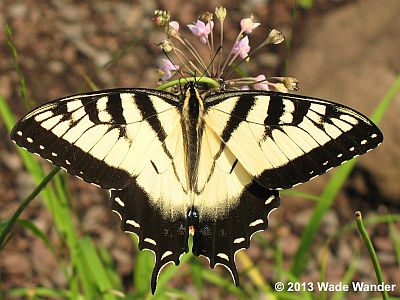
Male, Willowwood Arboretum, Morris Co., NJ, 8/4/07, on Field Garlic.
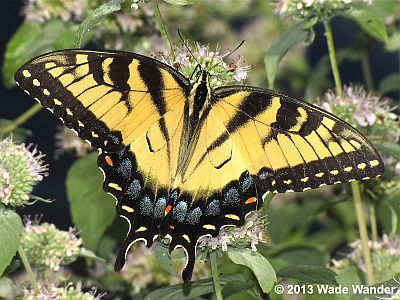
Female, Fredon Twp., Sussex Co., NJ, 7/24/10, on Hoary Mountainmint.

Female, Kittatinny Valley SP, Sussex Co., NJ, 8/13/11, on New York Ironweed.

Watchung Res., Union Co., NJ, 8/21/12, on Field Thistle.
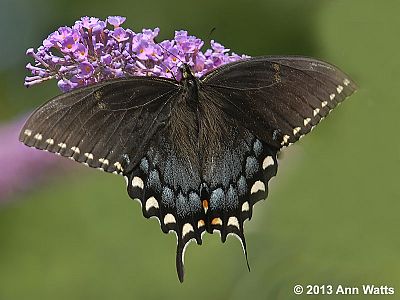
Dark Female, Scherman-Hoffman Sanctuary, Somerset Co., NJ, 7/7/06, on Butterflybush.
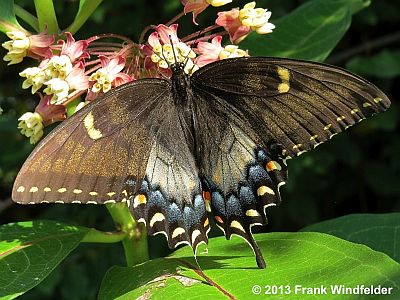
Intermediate Female, Horseshoe Bend Park, Hunterdon Co., NJ, 7/31/13.

Dark Female, Jenny Jump SF, Warren Co., NJ, 8/11/12, on Teasel.

Dark Female, Fairview Farm, Somerset Co., NJ, 8/21/12, on Field Thistle.
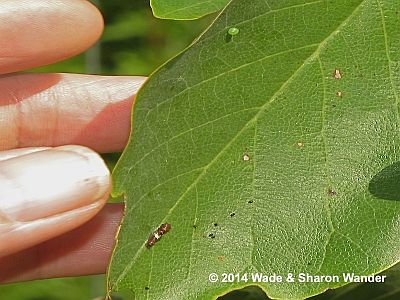
First instar caterpillar (by thumb), and egg (top of of photo) on ornamental magnolia leaf.
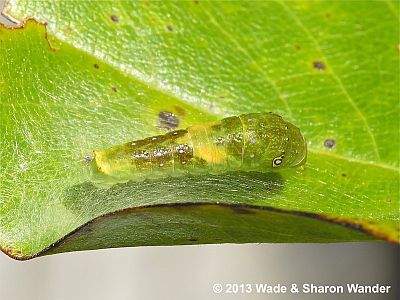
Middle-instar caterpillar.

Late-instar caterpillar.

Pupa.

Leaves of Tuliptree. This common tree of upland forests is one of the main caterpillar food plants of Eastern Tiger Swallowtail.